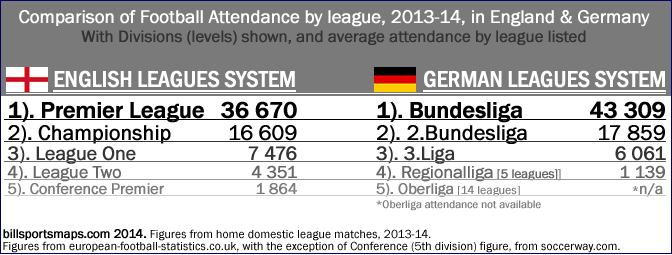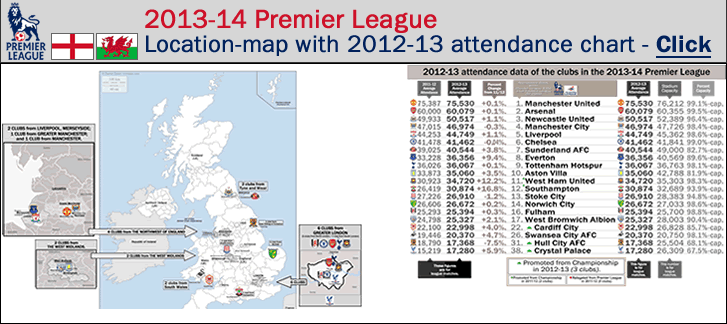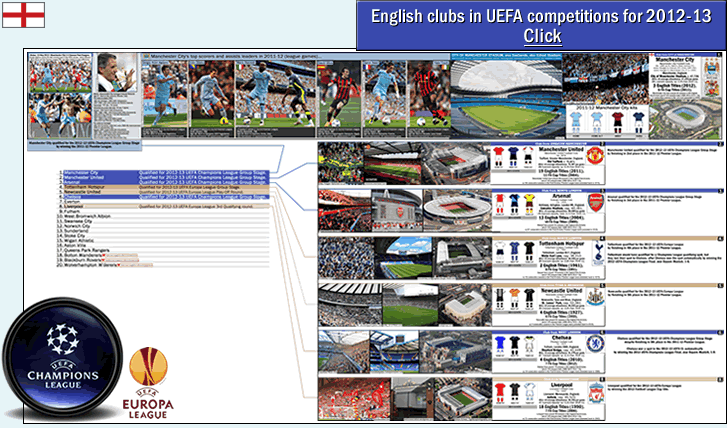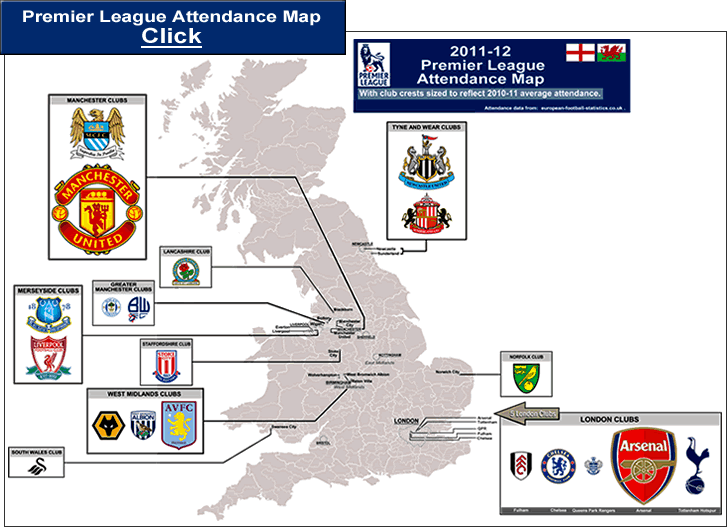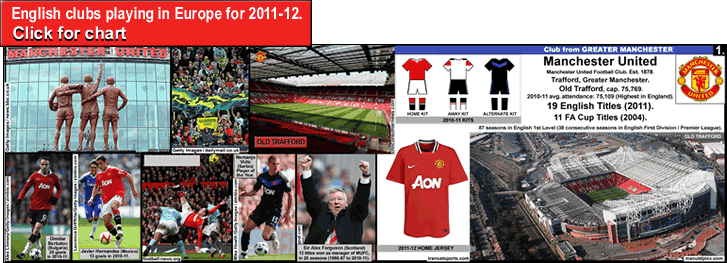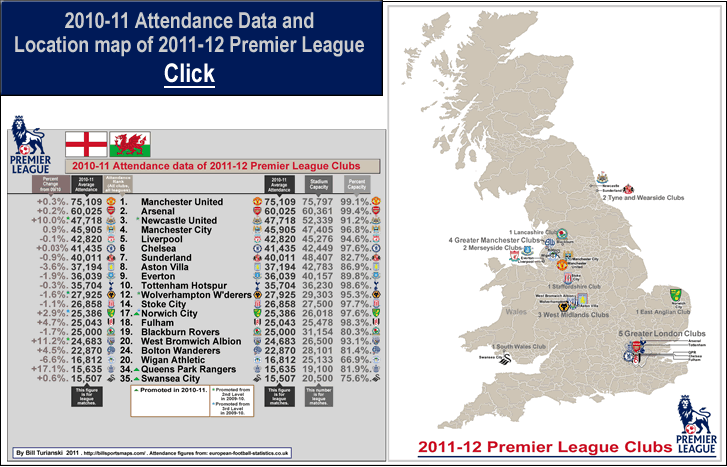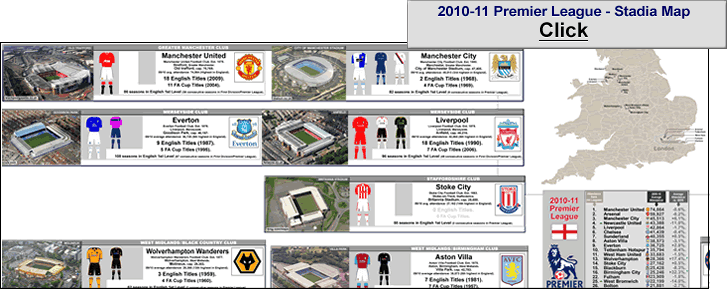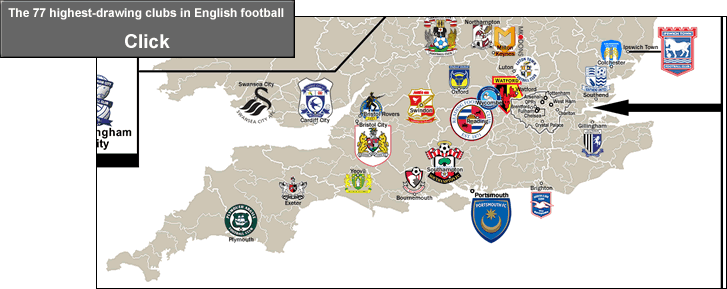
Premier League – 2013-14 home kit badges, with 13/14 location-map, and attendance data from the last two-and-a-half seasons
…
…
(Note – to see my latest map-&-post of the Premier League, click on the following: category: Eng>Premier League.)
…
After 8 home games for all 20 Premier League clubs, the club which is currently filling its stadium the closest to full capacity is Norwich City, who are playing to 99.2 percent-capacity at their 27,033-capacity Carrow Road in Norwich, Norfolk. Last season (2012-13), Arsenal had the best percent-capacity at 99.5 {see this}; two seasons ago (2011-12) the best was a 3-way tie at 99.4 between Manchester United, Arsenal, and Tottenham {see this}.
The biggest numerical increases in attendance from 2011-12 (2.4 seasons ago)…
Crystal Palace, +8,054 per game versus 2011-12 average attendance.
Cardiff City, +5,378 per game versus 2011-12 average attendance.
Hull City AFC, +4,998 per game versus 2011-12 average attendance.
All 3 of those clubs were of course promoted to the Premier League last season (2012-13).
The clubs with the biggest numerical increases in attendance from 2011-12 which were not involved in a promotion since then are:
Everton, +3,276 per game versus 2011-12 average attendance.
Aston Villa, +3,100 per game versus 2011-12 average attendance.
Sunderland AFC, +2,833 per game versus 2011-12 average attendance.
The worst drop-offs in attendance:
Stoke City, down -1,646 per game since 2011-12.
Fulham, down -747 per game since 2011-12.
…
Below, Everton FC bows to fan pressure, and the club back-peddles on their crest change
From Daily Mail, from 3 October 2013, by Elliot Bretland, ‘Everton reveal new crest for 2014/15 season after original design was met with anger by Blues supporters‘ (dailymail.co.uk/sport/football).
With the ill-fated 2003-14 Everton crest re-design, the biggest issue most Everton supporters had was the dropping of the club motto, Nil satis nisi optimum, (which is Latin for ‘nothing but the best is good enough’). The club explained that they needed to re-design the crest because their crest was appearing in truncated forms at some media outlets, with the shield-shape shown but not the ‘Everton’ text block; and also that the color-shift in the centre of the shield (blue-to-lighter-blue) was not reproducing properly in some reproductions of the crest.
So Everton FC wanted to move the ‘Everton’ text element to within the shield, and streamline the whole image. On the then-new 2013-14 design, the motto wouldn’t fit (nor would the two wreaths). The 1878 formation date remained, as did Prince Rupert’s Tower (aka the Everton Lock-up, built in 1787 [as a holding cell for miscreants], on Everton brow in Everton, Liverpool, and is still standing today/ see below). For the then-new 2013-14 crest, the Tower illustration was also re-worked, and despite what one might think of the modernist detailing of the brick-work on the ill-fated 2013-14 crest, the actual depiction of Prince Rupert’s Tower on the 2013-14 crest was the first time the Tower was accurately drawn on an Everton badge – showing the correct roof details and the correct proportion of conic roof to cylindrical body (the turret). Previously, the turret of the Tower was drawn too tall and thin in the badges from the 1978 to 2013 time period (see below). And on the previous Everton crest before this season – the crest the club had been wearing for the last 22 seasons (1991-92 to 2012-13) – the Everton Lock-up is depicted as multi-storied, with the turret actually above and below a spiraled structure (which has never existed on the actual Everton Lock-up). That fictional spiral structure on the 1991-2013 crest looks for all the world like an exterior spiral staircase. I mean, come on, what else can it be? It is not a fence that is sitting on a slanted hill…because you can see part of the turret BELOW the diagonal staircase structure. That is not the Everton Lock-up on the 1991-2013 crest, that is a three-story structure with a spiral staircase running around the outside of it making it look like a castle’s turret. It is totally made up. The edifice shown on the 1991-2013 Everton badge is an extremely fictionalized depiction of the Everton Lock-up. So is the earlier one (the 1983 to 1991 Everton crest). That one has turned the flat conical roof of the Everton Lock-up into a baroque witches-hat design, the sort of architecture one would find in illustrated fairy tales.
Furthermore, on 2 of the 3 the previous crests (the 1978-1983 crest and the 1991-2013 crest), the pinnacle of the conical roof was depicted not with the actual thing which was and still is there on the Tower – a ball (or spherical-shaped top cap), but with two crossed diagonal bits forming a V-shape (which makes no sense if you convert that to three dimensions). That V-shape did not exist at the top of the Tower. In past centuries the Eveton Lock-up did have a short spire (or maybe a lightning rod) {see this (liverpoolhistorysocietyquestions.blogspot.com)}, but not a V-shaped ornament.
I was honestly starting to think that whomever drew the Tower for the 1978-1983 crest, or for the subsequent two Everton crests, did not even actually stroll over to the Everton brow and have a look at what the Tower really looks like, let alone take a look at any photo of the real Prince Rupert’s Tower. Either that, or the illustrators were told by EFC top brass to not let the depiction look too literal, and err on the side of a more-attractive-looking Tower (ie, taller, thinner, and looking more like a fairy-tale castle than a typical old English village lock-up). It is one or the other, and I am now inclined to believe that 35 years ago, and 30 years ago, and 22 years ago, and 3 months ago, Everton top brass were trying to sugar-coat the depiction of their iconic edifice on their crest by making it look more benign. In other words, they were trying to make the jail house (gaol house) that is on Everton’s crest look less like an old English overnight lock-up for recently arrested common criminals (which it was), and more like a nice-looking turret on some quaint old castle. Or made it look more like a lighthouse, which I initially thought it was when I first started following English football a decade ago.
To prove that there was no change in the shape nor in the pinnacle detail of the actual Prince Rupert’s Tower since those gussied-up and fanciful depictions of the Tower which existed on Everton’s badge from the 1978-2013 era, here is an old photo, ‘Old Police Lockup‘ (photo by Ken Rose at peoples-stories.com), from about 1948, that shows that same squat dimensions of the Tower and the ball at the pinnacle of Prince Rupert’s Tower, and not the fictional elongated tower-shape and the odd V-shape at the top of the Tower. Here is a photo that shows how short and squat the Everton Lock-up is, as you can see that the top of the lock-up’s doorway is only a few feet (not even a meter) from the roof-line {‘Prince Rupert’s Lock-Up‘, photo by Andrew Merryweather at flickr.com)}.
The new Everton crest for 2014-15 (voted for by Everton supporters in October 2013) restores the club motto and the wreaths to the crest. The Tower, however, is once again erroneously drawn as too tall and too thin, and the fact is for the new 2014-15 badge, the Everton Lock-up is depicted as a two-story structure. But at least the ball is up there at the pinnacle of the Tower like it always should have been.
From 29 May 2013, from The Football Attic – the Football Attic podcast #9, ‘Team Badges [with info and opinions on the Everton FC 2013-14 badge re-design]‘ (thefootballattic.blogspot.co.nz).
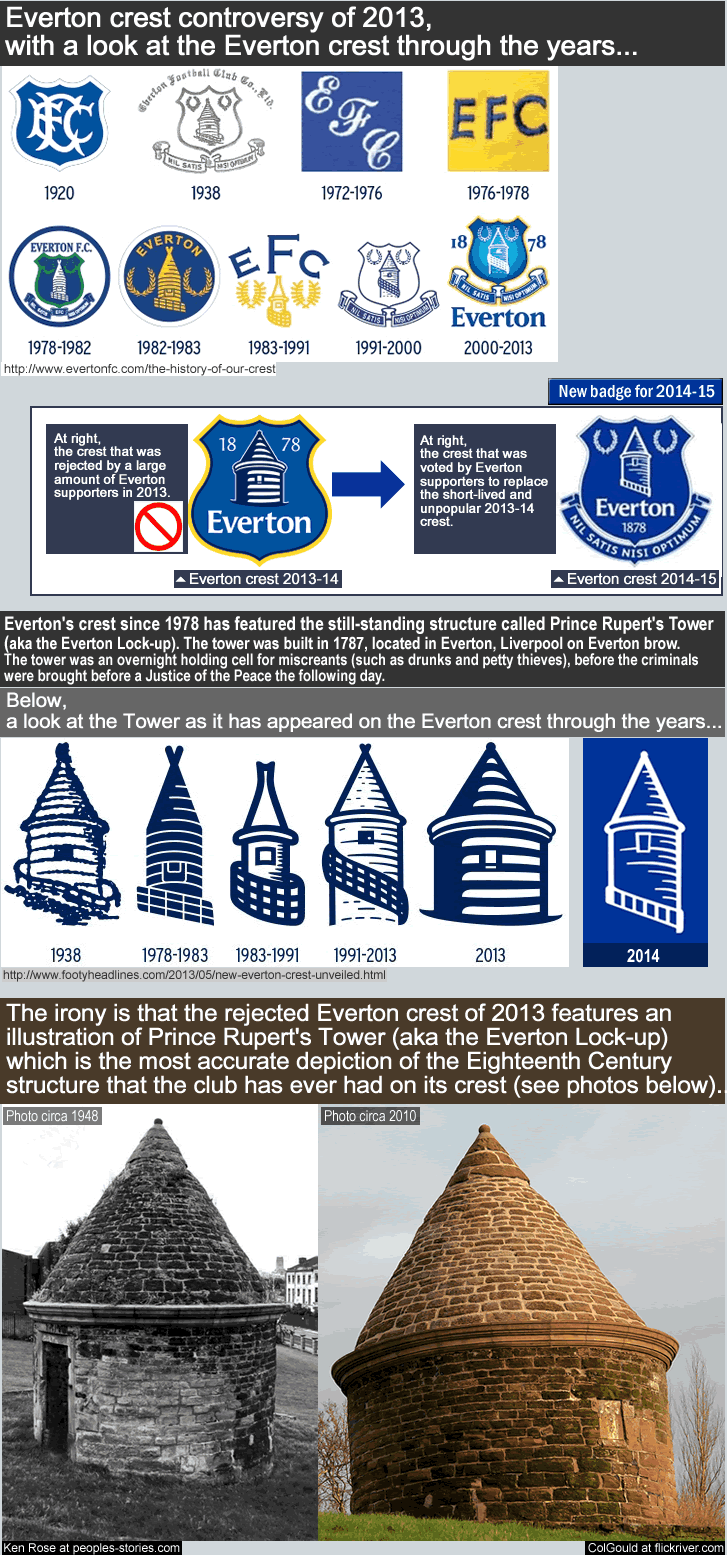
Image and Photo credits above –
Everton crests through the years from evertonfc.com/the-history-of-our-crest.
Prince Rupert’s Tower images on Everton crests from footyheadlines.com/2013/05/new-everton-crest-unveiled.
Photo of Prince Rupert’s Tower by ColGould at flickriver.com.
…
Below, the Crystal Palace FC crest re-design for 2013-14
From Cafe Thinking blog, from 8 May 2013, ‘New Crystal Palace FC badge scores with the fans‘ (cafethinking.wordpress.com).
The new Crystal Palace crest was voted upon by Crystal Palace fans before the decision was made, not after, like at Everton, so no controversy ensued.
I like the 1955 Crystal Palace crest the best (see below). First of all, the eagle never existed in Crystal Palace FC tradition at all before 1973 – when the bombastic Malcolm Allison re-named the club’s nickname as ‘the Eagles’ instead of ‘the Glaziers’, and an eagle-with-football crest was introduced (the club also switched from white jerseys with claret-and-sky-blue trim to blue-and-red-vertical-striped jerseys in 1973-74). So for CPFC, the eagle really was just invented iconography and invented terminology, and is not an organic (or relevant) part of the club’s history, and smacks of the dreaded Americanization of English football nomenclature (see also, currently, the Hull Tigers controversy). And why does a club with so rich a history also need an eagle as a nickname and as the prominent crest element, when the club is named after a unique and storied and innovative and awe-inspiring Victorian era crystal-and-iron structure?
The Crystal Palace in South London was the first home of the club, and several members of the original squad were in fact glaziers and maintenance workers at The Crystal Palace back in the first decade of the 20th Century (ie, circa 1905). That to me is way more impressive than a random-but-supposedly-dignified nickname (the Eagles), which some big shot in a ridiculous big white hat (Allison) simply made up when he was in control there for a brief 3-and-one-quarter seasons spell in the Seventies. First off, he doesn’t deserve all the blame for being the manager who oversaw Crystal Palace’s relegation from the First Division in 1973 (Palace were too far behind that season too be realistically expected to survive the drop when Allison took over there in March 1973). However, Palace did lose 5 of their last 7 games that year, so he gets the blame for that I would imagine. Furthermore, the rest of Allison’s record as Crystal Palace needs to be pointed out. The following season, his first full season in charge at Palace, he got them relegated to the third division, in May 1974. So they went from the first division to the third division with Allison in charge. And they were still stuck in the third tier when he walked away from the job in 1976. And when Malcolm Allison was manager of the club for the second time, in 1980-81, when Crystal Palace were back in the First Division but were once again in a doomed relegation battle, Crystal Palace once again found themselves relegated with Allison at the helm. It must be pointed out that as in 1973, Palace in March 1981 were many points off safety when Allison took over. Palace were relegated to the second division, in May 1981. But then he waltzed off again. And that to me is the most damning. Talk about not being able to finish a job. So let me get this straight – this is the guy who gave Crystal Palace their nickname and their visual identity? A guy who dressed like a pimp and who got the club relegated three times in the 5 seasons he was in charge there at Selhurst Park? But then just left both times, with Palace worse off from when he started?
One could argue that The Crystal Palace is still there in the CPFC crest to this day (as you can see below). But I would counter that The Crystal Palace structure as it appears in the current CPFC crest has become a secondary aspect of the crest, by virtue of it being depicted in pale grey, at the bottom of the badge, dwarfed by the eagle.
Here is an excerpt from the Historical Kits page on Crystal Palace, written by Dave Moor,
{excerpt}…’FA Cup finals were staged at the Crystal Palace in South London a unique football venue set in extensive parkland, between 1895 and 1914. The original Crystal Palace was an enormous glass and cast iron structure built in Hyde Park for Prince Albert’s Great Exhibition in 1851 and represented Victorian engineering at its finest. When the exhibition closed, the palace was dismantled and rebuilt in South London where it formed the centrepiece of the world’s first entertainment theme park, surrounded by landscaped garden, lakes, spectacular fountains and concrete dinosaurs.’…{end of excerpt}.
Before Crystal Palace FC were allowed to join the Football League in 1920, and when the club was initially a member of the Southern League, the club played at The Crystal Palace in South London from the club’s inception in 1905 until mid-1915, when, at the onset of World War I, the ground was seized by the Admiralty (the British Navy) for the war effort. Crystal Palace FC found a ground nearby (at a velodrome), and a decade later the club moved into the nearby site where Selhurst Park was opened, in Croydon Park, South London, in August 1925. The Crystal Palace was destroyed by fire in 1936. ‘The Crystal Palace‘ (en.wikipedia.org).
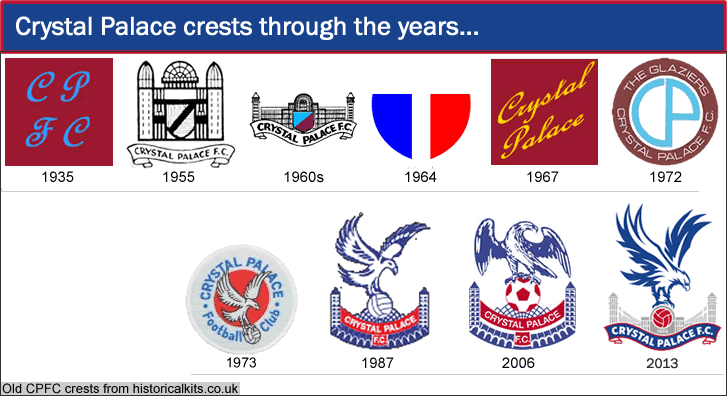
Old CPFC crests from http://www.historicalkits.co.uk/Crystal_Palace/Crystal_Palace.htm.
…
Below, the ongoing fiasco that is the divisive re-branding of Cardiff City FC
The Cardiff City jersey-and-crest controversy of 2012 can be summed up this way…as soon as Vincent Tan is gone, Cardiff City will wear blue again. End of story. I give it 2 more seasons, then when Tan realizes the extent of the enmity he has created and the lack of actual support he has within Cardiff, then the ego-inflated, sycophant-surrounded, football-clueless Malaysian will get bored with his new toy, sell the club, and slouch off back to the corrupt regime from whence he sprung. In the meantime, Tan’s juvenile insistence on changing Cardiff City from red to blue has distracted and divided the fans during what should be a joyful time for all Cardiff supporters, with the club’s first top flight appearance in 51 years.
From The Guardian, from 2 Nov. 2013, by Daniel Taylor, ‘Vincent Tan’s antics leave Cardiff’s faces as red as their shirts…We’ve seen the sort of boardroom buffoonery taking place before – and it rarely ends well for the fans‘ (theguardian.com/football/blog).

Image and Photo credits above –
Old CCFC crests from kassiesa.nl/uefa/clubs/html/C; uefa.wikidot.com/england:cardiff-city-fc.
[Template for CCFC crests from last 25 years from http://en.wikipedia.org/wiki/Cardiff_City_F.C.#Club_logo_history.].
Photo of Tan, from Getty Images via dailymail.co.uk/sport/football/article-2402081/Cardiff-owner-Vincent-Tan-adds-teams-kit-shirt-tie-combo.
Photo of Cardiff City fans from Reuters via mirror.co.uk/sport/football.
Photo of ‘Tan Out’ T-shirt uploaded by mugitmugit at ebay.com, ebay.co.uk/itm/Tan-Out-Cardiff-City-Bluebirds-t-shirt.
Photo of Cardiff City fans’ protest banner from msn.foxsports.com/foxsoccer/premierleague/story/cardiff-fans-stage-protest-against-owner-vincent-tan-before-boxing-day-fixture.
…
Here are the photo credits for the jersey badges on the map page –
Photo of Arsenal 2013-14 home jersey badge from dreamsoccerjerseys.com/arsenal.
Photo of Crystal Palace 2013-14 home jersey badge, unattributed at footballkitnews.com/new-crystal-palace-kit-13-14-cpfc-home-away-shirts-2013-2014.
Photo of Everton 2013-14 home jersey badge, unattributed at footballkitnews.com/new-everton-kit-1314-nike-everton-fc-home-jersey-2013-2014.
Photo of Liverpool 2012-14 home jersey badge (liverbird with L.F.C in gold), by Pub Car Park Ninja at flicker.com; Pub Car Park Ninja’s photostream.
Photo of Manchester City 2013-14 home jersey badge, unattributed at footyheadlines.com/manchester-city.
Photo of Manchester United 2013-14 home jersey badge, unattributed at tsmplug.com/manchester-united.
Photo of Southampton 2013-14 home jersey badge from ssl.saintsfc.co.uk.
Photo of Sunderland 2013-14 home jersey badge from footyheadlines.com/sunderland.
Photo of Tottenham 2013-14 homes jersey badge from: dreamsoccerjerseys.com.
Photo of West Bromwich 2013-14 home jersey badge from footballshirtculture.com/west-bromwich-albion.
…
Thanks to the the contributors at en.wikipedia.org, ‘2013–14 Premier League‘.
Thanks to the following sites for average attendance figures -
Thanks to soccerway.com, for current attendance figures, int.soccerway.com/national/england/premier-league/20132014.
Thanks to european-football-statistics.co.uk, for 2012-13 Premier League attendance figures.
Thanks to the Football League official site for 2012-13 Football League Championship attendance figures, http://www.football-league.co.uk/page/DivisionalAttendance/0,,10794~20127,00.html.
Thanks to Chris O. and Rich J. at the Football Attic site and podcast, for pointing out that the ill-fated Everton 2013-14 badge actually has the most realistic depiction of Prince Rupert’s Tower that any Everton badge ever had (regardless of whether EFC fans liked it or not).

